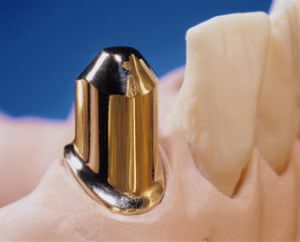 Telescopic crowns are an orthopedic structure on which a removable prosthesis is attached. They differ from traditional crowns with strength, aesthetics, convenience and reliability of fixation.
Telescopic crowns are an orthopedic structure on which a removable prosthesis is attached. They differ from traditional crowns with strength, aesthetics, convenience and reliability of fixation.
They got their name because of the design features. This orthopedic product consists of two inner crowns, which are attached to the support and external, located in the most removable prosthesis. They are inserted one into the other, as in a telescope.
The manufacture of telescopic crowns is a complex process. And what the final result will be depends largely on the skill of the dental technician and the alloys used. Any minimal disruption in production or use of poor quality raw materials will lead to undesirable consequences.
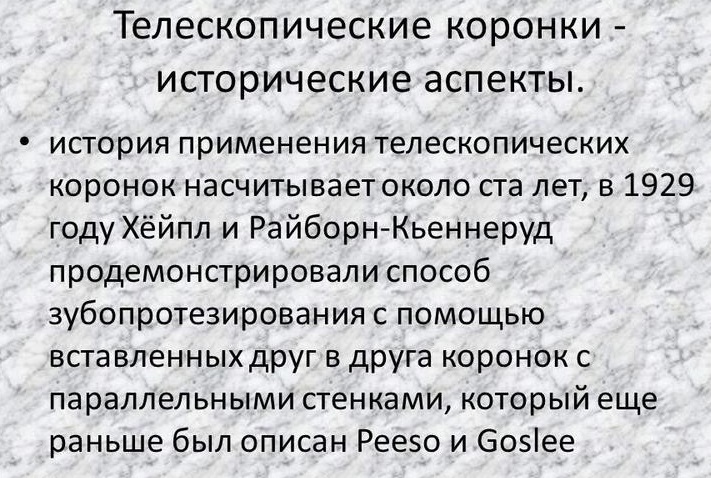
Contents
- Design options
- Design features
- Applied technologies and raw materials
- Indications and contraindications for
- installation Alternatives
- Prosthetic stages
- Pros and cons of crowns with telescopic structure
- Operation and care characteristics
- Patient's opinion
- Question price
Variants of constructions
The followingvarieties of telescopic crowns:
- Cylindrical .Their walls are parallel to each other and function by analogy with the piston. If the patient has healthy periodontal tissue, then it is recommended to put this type of crowns. The reliability of the fixation of the cylindrical crowns depends on the quality of the structure and the tightness of its parts. They are rarely put, because they are difficult to do.
- Cone .They are more reliable and more durable than cylindrical ones. They are easier to make. They can not be jammed or twisted, they are able to take the right position. The more pronounced the taper of the product, the less effort is needed to separate the inner and outer crown. But if the clutch is weak, then the device can be disconnected by the tongue, with the use of sticky food, for example, toffee.
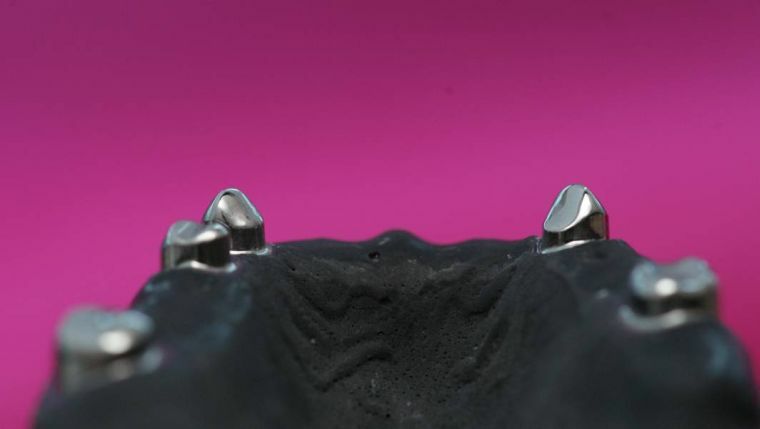
On the photo cylindrical( closer to the viewer) and cone telescopic crowns
Design features
Telescopic prosthesis consists of 2 parts:
- Fixed part or patrician .This is a cap that is fixed to supporting teeth with cement, or fixed on implants. In appearance, it looks like a thimble.
- Removable part or matrix .It is fixed on the patrician. It can be a bridge or clasp prosthesis.
When the matrix is put on, it is securely fixed to the patrician thanks to the design, and if necessary, easily removed.
Applied technologies and raw materials
For the production of telescopic crowns, casting and stamping are used.
With the help of stamping it is easier to make an orthopedic device, but when casting the telescopic fastening turns out to be more precise and it can be covered with a special substance that allows to improve its appearance. 
It is recommended to use gold or metal alloys as materials. Recently, more and more popularity is gaining designs from zirconium, which are covered with gold plating. This is a more budget option.
It is desirable to make a matrix and a patrician from a similar material, of course, when this happens.
Alloys used in production are hypoallergenic, they do not harm health and are not oxidized in the oral cavity.
Indications and contraindications to the
installation Telescopic crowns are recommended to be installed when: the
- has lost a large number of teeth;
- , there is a chance of losing the remaining teeth;
- person wants to have a prosthesis, which is securely fixed and invisible to others, as it does not differ from natural teeth.
Telescopic prosthesis is not recommended for installation if a person has:
- excessive abrasion of enamel;
- abnormal localization of supporting teeth;
- pathology, in which it is impossible to grind enamel;
- diseases of peri-toothed tissues.
Alternative variants of
There are following alternative methods of prosthetics:
- implants, which can be installed in place of any removable orthopedic structures, but they are incommensurably more expensive;
- removable dentures are worse attached and less comfortable to use than telescopic crowns, and sometimes, to remove them, teeth extraction is required;
- soft models wear out more quickly and if they break, then they will not be able to recover;
- clasp dentures on micro-locks, but they can not be installed if a person has few teeth.
Stages of prosthetics
The installation is as follows:
- pre-dentist conducts the sanation of the oral cavity;
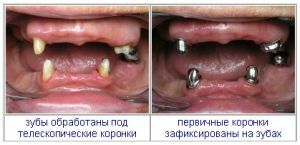
The need for teeth sharpening - the main disadvantage of telescopic prosthetics
- teeth, if they can not be restored, remove;
- prepare the supporting teeth: kill the nerve in them and grind them under the inner crown;
- make a mold, according to which the model is made;
- tries on it and determines the parallelism of the walls of supporting teeth;
- make caps;
- after an accurate fit of the patrician on the supporting teeth, it is transferred to a plaster mold and a model is made on the basis of it;
- further in the laboratory model the outer part of the crown;
- the ready prosthesis is tried on and fixed in the oral cavity.
Stages of manufacture of telescopic crowns and installation of prostheses on their basis:
Pros and cons of crowns with telescopic structure
Telescopic locking system has the following advantages:
- does not violate speech;
- quickly adapts to the replacement device;
- they can be attached to a turned tooth or to an implant;
- they are distinguished by their strength and durability;
- orthopedic device is invisible to others and reliably fixed in the oral cavity;
- is easy to care for;
- such a prosthesis does not cover the salivary glands, so a person will not dry out in the mouth;
- long service life( with proper care, the prosthesis can be worn for up to 10 years);
- there is no palatal part, so this design does not cause inconvenience and with its use the gag reflex is excluded;
- with the loss of another tooth orthopedic device can easily be remade;
- the chewing load is evenly distributed on the supporting teeth, which positively affects the periodontal tissues;
- if necessary, you can easily replace one crown, and not make a new orthopedic design.
The following can be attributed to cons:
- with time, the mount weakens, and the design needs to be adjusted, it should be done every 3-4 years;
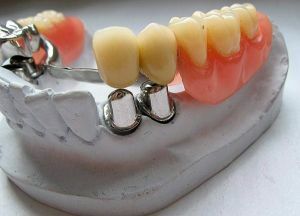
- for installation requires more space between the teeth than when installing conventional crowns;
- technique is not sparing, as it requires turning teeth;
- if the prosthesis is installed on implants, then in the event of a breakdown it will be necessary to change the entire structure;
- will have to devote enough time to hygiene of the oral cavity to remove plaque, food residues between the parts of the structure and to prevent the appearance of carious cavities,
- over time, prosthetics last long, it will be necessary to repeatedly visit the dentist in order to try on orthopedic construction;
- high price.
Features of operation and care
In order for the prosthesis to last a long time it is necessary to observe such rules:
- You can wear it around the clock.
- To remove the orthopedic device it is necessary only for carrying out of hygienic procedures. Do not use abrasive agents for cleaning. Otherwise, you can damage the prosthesis.
- The construction should be removed before the sink, looking in the mirror. To prevent damage to the prosthesis during an accidental fall in the sink, it is necessary to lay a soft cloth.
- Regular check-ups should be performed to identify any abnormalities and eliminate them.
Patient's opinion
How is life in general?
I was given clasp prosthesis for telescopic crowns. Adapted to the orthopedic design quickly. I like that it is invisible to strangers.
Svetlana, 46
I'm used to telescopic crowns not with a rhinestone. But now I'm happy with them, at last they can smile.
Alexey Leonidovich, 51
Price
The cost of manufacturing and installing a telescopic prosthesis depends on the materials used, the particular clinic and the prices of the doctor's services. And also on the number of teeth for fixing it. The average price for such designs starts from 35 thousand rubles.
